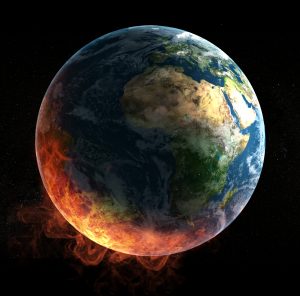This week, the U.N.’s Intergovernmental Panel on Climate Change (IPCC) released its latest summary report. As expected, the report is not exactly suffused with optimism. It finds that the Earth is now virtually guaranteed to warm at least 1.5 degrees Celsius over the preindustrial baseline in the coming decades, even if a massive global effort succeeds in reducing emissions over the next few decades. By itself, that will create more extreme weather events, and it may also precipitate other unpredictable but severe systemic collapses, like the shutdown of the Gulf Stream.
At this point, a significantly altered global climate is not a theoretical impossibility (though certainly if meaningful action is taken in the next few years it might limit the extremity of the change). The IPCC report is only confirming what has become painfully obvious from observing current events. The last few months have seen numerous, simultaneous extreme weather events: catastrophic flooding in China and Germany, overwhelming heat waves in normally temperate Western Canada, record-setting drought and wildfires in the American West, and more.
In short, the environment upon which virtually all human activity depends is undergoing severe and potentially irreversible change. It is changing the world that we will live in, and the world that national security policies must be made for. Any strategy that does not at least recognize this truth is useless.
In a previous column, I explored the challenges and contradictions of adapting the U.S. military for climate change. This is a different and more strategic question: How should a country’s leadership think about continuing to secure its national interest while the ground shifts under its feet?
The short answer is that it will be much harder world to plan and prepare for. The climate is an intensely complex system, and though we know in broad terms what types of impacts to expect from 1.5 C or more of warming, we do not know many of the specifics of timing and localization; nor is it possible to predict the complex interactions of climate with agriculture, trade, patterns of migration, and other crucial human systems.
There are two basic models for thinking about how a radically hotter world will change geopolitics. The first is fundamentally Hobbesian. As rising waters and extreme weather simultaneously push populations out of critically endangered areas and create access to new trade routes or resources, whatever limitations that states have accepted on their behavior since World War II could largely be abandoned. The wave of nationalism that has seen such an upsurge over the last decade will be accelerated by the perception that the correct exercise of national power on a warming planet is to secure the biggest possible piece of a shrinking pie for the nation. That mindset leads almost axiomatically to violent struggle.
The other is model is collaborative. Realizing that the threat to lives, livelihood, and prosperity posed by a rapidly warming and transforming planet exceeds the danger of national competition, states could collaborate on reducing emissions, responding to extreme climatic events, and any more extreme measures, such as geoengineering, that may become necessary in order to stabilize the climate. But this mindset requires nations to profoundly reconsider their strategic priorities and make common cause with rivals, which is anathema to strategic establishments focused on competition.
That suggests that the fundamental challenge is one that will be familiar to anyone who has studied the Prisoner’s Dilemma: cooperate or defect. But like the climate itself, geopolitics is complex; neither of these models is likely to fully encompass how the world will respond over the coming decades. States, after all, can generally walk and chew gum at the same time; it should be broadly possible for the better-resourced ones, at least, to maintain a robust national defense while also reconfiguring toward climate harm reduction and resilience measures.
But the problem is that while states may have the underlying capability to advance multiple priorities simultaneously, their leadership may not be quite so flexible. And thus far there is little reason to think that national leaderships are willing to steer decisively toward the cooperative model. China, the world’s largest current emitter, has invested heavily in solar power and battery production, but is also bringing massive amounts of coal-fired power online in the next few years. The United States, the largest historical emitter, vacillates between governments that institute insufficiently ambitious policies and those that actively seek to roll back even those modest gains.
Nor are things necessarily better elsewhere; the middle powers have made some commitments – and some have made substantial progress since the Paris Accords – but probably not enough to change the overall trend. Meanwhile, there is a fundamental question of fairness to be resolved: How to limit climate harm without cutting off opportunities for growth and development for the billions of people in the developing world, who did not benefit from carbon-intensive economic growth.
The way these different incentives interact with the speed of change in the climate makes an overly prescriptive strategy virtually impossible to put into practice. But the change in the environment must be baked into any national strategic analysis of the coming decades; a strategy that does not do so is worse than useless.

































